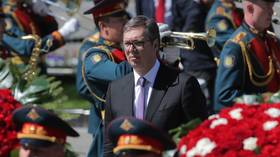US regressing into a developing nation for most people, MIT professor warns

Growing income inequality is turning the US into a dual economy, with one economy for the rich and another for the poor, according to an MIT professor, who warns that the middle class is vanishing.
In his new book, “The Vanishing Middle Class," Peter Temin, professor emeritus of economics at Massachusetts Institute of Technology, warns that the US is moving backward and becoming more like a developing nation, as the “the vanishing middle class has left behind a dual economy.”
“We are still one country, but the stretch of incomes is fraying the unity of the nation,” Temin wrote in the introduction of his book, according to a copy obtained by Barnard College.
The economist describes a dual economy, where the gap between the rich and the poor has grown wider.
Temin points to a study from the Pew Research Center, which, he said, “shows that the income share lost by the middle class has gone to people earning more than double the median income.”
“In short, the rich got richer. The poor did not disappear, and the middle class shrank sharply,” Temin wrote. “We are on our way to become a nation of the rich and the poor with only a few people in the middle.”
"America’s middle class has lost nearly 30% of wealth" - @MarketWatch on our report https://t.co/piGdKVD1kPpic.twitter.com/ynaYwWyOal
— Pew Research Center (@pewresearch) December 10, 2015
Temin argues that American history and politics had a lot to do with the increasing wealth inequality.
Over a period of 40 years, from World War II to the 1970s, Temin said that wages grew with the rest of the economy. Then, starting in the 1970s, national production continued to grow, but wages did not.
“The middle class’s share of total income fell 30 percent in 44 years,” Temin wrote.
The wealthiest 20 percent of the population had access to education, good jobs and social networks, while the other 80 percent was increasingly burdened with debts, low-wage jobs, and health problems. Now, Temin said the conditions where many poorer Americans live in resemble developing countries, with dilapidated housing, crumbling public transportation, and roads and neglected social structures.
Temin splits the economy into the “FTE sector” (finance, technology, and electronics) and low-skill work. The economic gap between rich and poor began with the war on drugs, he said.
“The low-wage sector—like the FTE sector—was born in 1971 as President [Richard] Nixon replaced [President Lyndon B.] Johnson’s War on Poverty with a new War on Drugs and appointed Lewis Powell to the Supreme Court,” Temin wrote. “As the War on Drugs expanded in subsequent decades, it was enforced far more strongly for African Americans than for whites, becoming... the ‘New Jim Crow,’ revamping and renewing the racist intent of the repressive old anti-black Jim Crow laws that followed Reconstruction in the South.”
After that, Temin said, the FTE sector became driven by money and free-market individualism. They began to ignore the needs of the low-wage sector, turned away from public-spirited universalism to free-market individualism and even began to work against the low-wage sector.
The FTE sector was able to stay in power, Temin said, because of Investment Theory of Politics, which he describes as “the connection between the income distribution in the United States and political decisions.”
Investment Theory of Politics was developed by political scientist Thomas Ferguson, director of research at the Institute for New Economic Thinking (INET), who said that there is a direct correlation between the money major political parties spend and the votes they win.
The evidence can be seen in a simple graph from a study conducted by the Roosevelt Institute on the influence money had on the 2012 presidential election.

Temin used a model created by Nobel Prize winner Arthur Lewis, which was designed to describe how far inequalities have progressed in developing nations. When Temin used the applied the model to the US, he said: “The Lewis Model actually works.”
“We have a structure that predetermines winners and losers. We are not getting the benefits of all the people who could contribute to the growth of the economy, to advances in medicine or science which could improve the quality of life for everyone — including some of the rich people," Temin wrote, according to the Independent.
To break the cycle, Temin provides some recommendations, including reducing mass imprisonment, which costs around $1 trillion a year, or 6 percent of the total US gross domestic product, according to a 2016 study from Washington University in St. Louis, Missouri.
He recommends using the money to increasing funds for public education, so families can escape the low-skill trap and integrate into the broader economy.














